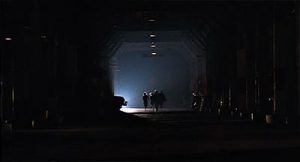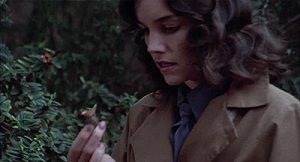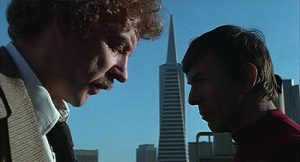Friday, October 5th, 2007
•
Horrorthon Posts / Horrorthon Reviews

1978 (*****)
If I was going to do a Horrorthon “Masterpiece Edition” series this movie would definitely be in it. It’s simply one of the best there ever was. I wasn’t necessarily going to review this but ac made a comment on my Invasion review Tuesday, suggesting that there might be some interest in that movie’s vastly superior predecessor.
As I explained below, Invasion of the Body Snatchers (1978) is itself a remake of Invasion of the Body Snatchers (1956), which is based on Jack Finney’s novel The Body Snatchers (1955). (There’s a 1990’s film version that I have not yet seen.) When this 1978 version was released (and I saw it in the theater) I remember that all the reviews were discussing it as a “modernized,” “updated” version with questionable changes, much the same way I’m discussing the Kidman version below. (I doubt anyone would have predicted they’d still be making this movie another thirty years later.)

Alien symbiotes come down in the rain over the Bay Area
The “fidelity” of the ’78 remake was an issue at the time, mainly because Finney’s novel and the first movie are set in a small rural town, while the ’78 version moves the action to San Francisco. Small-town local doctor Miles Bennell (Kevin McCarthy) becomes San Francisco Department of Health investigator Matthew Bennell (Donald Sutherland). Despite these and other minor changes, however, the ’56 version and the ’78 version are remarkably similar. The alien morphology is identical; the plot moves are basically the same; the pacing and the scenes are essentially following the same pattern. (The ending is quite different.) It’s really the same story (unlike the Kidman version); what makes this an absolute masterpiece of horror, the definitive version of the tale (in my opinion) is the incredible skill and artistry and intelligence with which the story is told.

Brooke Adams finds a hybrid flower
As I mentioned on the phone to octopunk recently, I think the greatest movies in the genre are the hardest to review. That’s a general trend in the arts: how do you “review” The Great Gatsby or Mahler’s 4th symphony? What do you say when the work of art in question is part of what makes you (and the world) understand what a “novel” or a “symphony” is to begin with? Invasion of the Body Snatchers had a tremendous influence on me when I saw it in the theater, not just because it scared the living crap out of me for weeks to come but because it was part of my early understanding of the art of movies and what movies could do. I was tremendously fortunate to grow up in the ‘Seventies because the movies of my childhood have pretty much all emerged as bona fide classics, thirty years later. It’s great when your period of greatest nostalgia turns out to be a “golden age” culturally in that way. But enough about me! What makes Invasion of the Body Snatchers so good? I’ll go through it categorically:
1) Phillip Kaufman
One of the legendary USC directors (along with Lucas and Coppola), Philip Kaufman worked in close harmony with Lucasfilm (he gets a story credit on Raiders because of a single, intense conversation he had with Lucas) and the rest of that gang. Kaufman went on to do The Right Stuff and Naked Lunch and other interesting movies, and his deft visual touch and skill with actors is almost definitely the reason that Body Snatchers is so damn good. Specifically, Kaufman brought in Ben Burtt (Oscar-winning sound maestro for the Star Wars trilogy) to handle the sophisticated audio effects in this movie. Additionally he got Michael Chapman (Taxi Driver; Raging Bull; The Fugitive) to shoot the movie and encouraged Chapman to use an innovative palette of photographic techniques, in order to properly set the tone of the piece. The first half-hour of Body Snatchers could be shown to any Hitchcock-loving film class as an example of how to build tension with photography and sound even when very little is happening. (If anyone rents the movie, it’s worth listening to Kaufman’s commentary track at some point, because he goes into great detail about all of this.)

Donald Sutherland and Leonard Nimoy
2) ‘Seventies Actors
Donald Sutherland, Brooke Adams, Jeff Goldblum, Veronica Cartwright, and Leonard Nimoy are the epitome of the 1970s ensemble cast, each turning in compelling naturalistic performances (like you’d see in a Woody Allen movie) and additionally providing a sense of community and friendship that’s perfect for the subject matter of this movie. As I described in the other review, the pod takeover is stealthy and gradual, depending on the pods believably passing for humans while their numbers increase over the crucial first few days of the invasion. There could be no better device for conveying this than a realistically-depicted and likable group of sophisticated, reasonably funky San Francisco professionals in their ‘thirties and ‘forties. Early scenes between Health Inspectors Sutherland and Adams, poet/bathhouse owner Goldblum, celebrity-shrink Nimoy and Goldblum’s granola-crunchy wife Cartwright could have come out of any of the superior ’70s movies about smart, beleaguered urban professionals. (The fact that Nimoy and Goldblum can’t stand each other makes for some great business between them.) Realism is crucial in tales of the fantastic, and the actors in this movie deliver such nuanced performances that when they begin to go down one by one (as you know is coming) the results are terrifying and heartbreaking. (The same remarks can be made, perhaps most fittingly, about Alien, which is the ultimate example of how much horror benefits from good actors. I’ve never been able to deal with Aliens because going from the likes of John Hurt and Ian Holm to the likes of Michael Bien and Bill Paxton is such a tremendous letdown; from Royal Shakespeare Company horror to TNT original movie horror.) Most importantly, the themes of the story—the value of human frailties and emotions in the face of growing alienation and fear and conformity—are brought into vivid relief by the performances.

Jeff Goldblum, Donald Sutherland and Veronica Cartwright
examine a partially-formed pod
3) What it All Means
Like I said up top, when genre movies are this good it’s difficult to review them in a conventional sense, because they “transcend the genre” (as is often said) and reach heights of expression and meaning that confound the usual templates for judgment. Movies like The Godfather and The Matrix are good enough that you stop thinking in terms of the specific limitations of “mob crime movie,” “sci-fi adventure” because those constraints are suddenly gone and the essence of what makes the genre compelling in the first place is laid bare in a new way. Invasion of the Body Snatchers (complete with lurid 1950s title) succeeds in precisely this way: it’s the same story as the other Body Snatchers movies, but it’s just so well done, so soulful, so intelligent, so gripping that you find it resonating in your head for a while after you’ve seen it. (This part may be nostalgia: I encourage Horrorthoners to watch this movie and let me know if I’m getting it right.) Stephen King wrote (in his excellent book-length essay on horror, Danse Macabre) that horror stories are crucial because they allow an unflinching look at our own deep psyches; our irrationality; our terror of mortality; our sensations of powerlessness or loss of control in a hostile world. Do you want all your fears to go away? Or do you want to stay who you are: a vulnerable and confused person in a hostile but beautiful world? If you choose the second option, then just remember: don’t fall asleep.
Tuesday, October 2nd, 2007
•
Horrorthon Posts / Horrorthon Reviews

2007 (***)
This movie flopped completely about two months ago (it only made $5 million). Which means that almost nobody will ever see it, ever…which is a shame. Am I recommending it? Not as such. Is it “bad”? We’ll get into that below. The important consideration here is that this is the real thing—a Body Snatchers movie in the strict Jack Finney sense—so it’s interesting to evaluate it according to special “Body Snatchers” criteria (and special “remake”/”adaptaion” criteria). I’ll be using this framework for my review rather than a conventional summary/commentary.
1) FIDELITY
They change the premise. This is interesting, because it significantly alters the progression of the story, and, maybe, kills the movie. Traditionally, the “body snatchers” are alien spores that land on Earth to take it over. They are biological parasites in the strict sense: you fall asleep next to one: while you sleep, the spore forms into a pod, which gives birth to a full-sized duplicate of you. The procedure reduces your real, sleeping body to desiccated mulch. Meanwhile the “pod person” of you awakens, puts on your clothes, and goes off to live your life. The new version of you is a hybrid: it has your memories and can convincingly pass for you (in most situations) but it’s not “actually” you; it’s one of the “body snatcher” entities and it’s got an agenda that will involve precise conspiracy with other pod people in order to spread the pods and accomplish the invasion.
Note that already we’ve got some very powerful ideas and some seriously intriguing ontological concepts (which is probably why Finney’s novel has been filmed four times). Setting aside the cultural/political/psychological metaphors (see below), this alien birthing procedure is very interesting in terms of the questions it raises. In all versions, pods say things like “When you wake up, you’ll be one of us,” which is, strictly, not true: the fact is you won’t wake up at all, but the elements of your psyche that get reproduced into the pod person are responsible for the pod person saying things like “It’s not so bad; join us” etc. It’s very strange to think about. What happens when all the humans are gone and the pod people have completely taken over? Do they sexually reproduce? Do they continue wearing clothes, riding motorcycles and behaving like humans, or was that just for our benefit?
The Invasion changes the premise significantly. Now, there are no “pod people” as such. It’s just the original people, having undergone an alien symbiotic transformation (the “pod” cellular material is inside them) so that they’re now “part of it.” There are no pods, no spores, no unformed bodies on slabs, no decaying original copies to be surreptitiously dispensed with. Why make this change? Probably just to come up with “something new” (rather than attempting to “correct” an error in the premise, which is why they changed Spider-Man’s webs for the movies and nobody minded). In the new version, you get infected first (usually by a “pod person” who’s attempting to fake you out by serving you coffee with the alien fluid in it) and now you’ve got to watch out because the next time you sleep, you wake up as one of them..
In other words, all those familiar sequences with big watermelon-looking pod props are gone. Also, the new premise creates “sleeper” pod people (literally) who seem to be fine until they doze off and wake up as aliens. In terms of narrative speed, it’s the same kind of change as “fast zombies,” and from that standpoint it’s effective as hell: this invasion moves very fast with scenes that are extremely fast-paced, neo-Bourne vignettes. The problem is the same as the problem in The Faculty (which is really sort of a comedy): it’s all reversible. Once a certain conclusive thing happens towards the end of the movie, the pod-people effect just…wears off; goes away. This is a major problem and I really think that, if any one thing “kills” the movie, this is it. It’s just no fun without the original versions of everyone rotting away into nothing.
2) EARLY PARANOID SEQUENCES
This is the whole point of “body snatcher” movies, because it’s the part that serves the essential horror-story purpose of exaggerating our actual fears. After fifty-three years (Finney’s novel was published in 1955 and the first movie was a year later) it’s fair to say that the “body snatcher” concept is as durable as Zombies (but not quite in the same league as Vampires, Werewolves and straight-up ghosts). The specific type of paranoia being exploited is extremely compelling and powerful, and lends itself to metaphors and dense interpretation (see below).
The first thing you realize about The Invasion is that it’s Right Now, the present day. CNN, cell phones, psycho-tropic drugs, the internet, AIDS, Iraq, 9/11. It’s an enormous difference and it makes for a spellbinding and very promising opening. Watching late 1970s movies always makes one wonder how the same story would occur in today’s world. (“Cell phones would change this story completely” is a thought I have very often while watching older movies.) Here, we get to see it. The aliens’ arrival on Earth is NOT unnoticed as in the other versions. A U.S. Space Shuttle crashes after encountering something in far orbit and it’s immediately all over cable news: BIOHAZARD! for about three days. We see all of this in a fast-paced montage and it’s incredibly good; incredibly REAL.
The early stages of the invasion are superb. Veronica Cartwright shows up to deliver the famous “My husband’s not my husband” line. Placid street-scenes are interrupted by terrified people running through, with no explanation. Strange glances from passersby, the chilling realization that the personnel in charge of containing the “biohazard” are all pods; the attempts to understand bizarre lapses in behavior. All of this, I repeat, is superb. I kept thinking, “This movie’s got to get worse, because if it stays this good, it would have been a monster hit.”
3) LATER PARANOID SEQUENCES
Even better. I’m talking about what happens when the pods have taken over and there are a few human hold-outs trying to escape or blend in. This is where The Invasion really knocks it out of the park. A woman is chased down the street by cops; she is muttering “Don’t sleep, don’t sleep, don’t sleep” as she stumbles and is caught. Various people here and there turn out to be terrified humans trying to blend in (it’s much harder than it looks). Extremely good day-player actors are convincing as hell as Kidman etc. encounter them in the subway or on the street.
The altered premise both improves and weakens these sequences. “Improves” because they’re faster and more intense (to quote a certain director). “Weakens” because, as you may have already figured out, the whole “Day/Night” rhythm of the story is gone. People turn into pods very fast, and they don’t have to have slept very long at all (since it’s a transformation and not a replacement; nobody’s “snatching” anything, which is obviously why the title was changed).
4) THE ENDING
Sucked. I won’t go into detail but I’m sure you can figure out where the story goes just based on my reference to “The Faculty.” Everybody walks out of the theater feeling lousy and the movie makes $5 million. This is seriously one of those flicks where the quarterback fumbles the ball mere yards from the end zone; you know what I mean.
5) METAPHORS AND SYMBOLISM
This part is very interesting, because (unlike Zombies, Vampires and Werewolves) pod people have their social commentary “built in.” What I mean is, traditionally the “body snatchers” movies are examined with an eye toward the current society and what they’re saying about it. The Invasion was made by people who respect this tradition, and what they’ve come up with is interesting. The 1950s original is generally understood to be about McCarthyism (although Finney denies it) but it’s also been viewed as a metaphor for creeping Communist sympathy. It’s very difficult for us to understand the mood of that time; I think Clooney’s movie about CBS really does a great job of conveying what that atmosphere was like. The 1970s version is a firmly “anti-establishment” film in the most glorious 1970s sense: Nimoy’s character, the feel-good pop shrink who tries to use slick therapeutic techniques to reconcile an estranged couple whose real problem is that the husband has been REPLACED BY AN ALIEN, is himself a sinister figure in the story.
The new version is ambiguous and intriguing: first, it must be noted that the Invasion ends all Middle-East conflict. We get to see this on CNN, in the movie: American troops vacate Iraq; the Gaza strip is peaceful, etc. Meanwhile, rather than Nimoy, Nicole Kidman’s character herself is a shrink. When Veronica Cartwright appears, panicking because her husband has changed, Kidman gives her a new anti-depressant prescription. Later, Kidman’s pod husband makes the movie’s big “pod person speech” (it was Nimoy in the 1978 version) trying to persuade her that “their new, peaceful world” is no different from the Prozac-fueled reality she wants to create for her patients. I don’t know what this all means; it’s sufficiently thought-provoking that I wish the movie held together well enough to support this kind of speculation.
6) CONCLUSION
I hope the failure of this movie doesn’t stop them from making more. It really is one of the better concepts in horror. If you want to see how that concept plays in today’s world, The Invasion is worth watching, just so long as you don’t let the quarterback’s fumble ruin your good time.
Monday, October 1st, 2007
•
Horrorthon Posts

1) I will watch horror movies. I will not get anywhere near the sheer volume of titles watched by the other participants. I will review the movies as is appropriate.
2) I will comment on other reviews. I will in so doing occasionally express a certain amount of (for example) extreme contempt for certain movies or filmmakers or (alternatively) extremely long-winded adulation for others; this should be interpreted within the framework of Horrorthon wherein it’s just a bunch of half-assed opinions and nobody gets hurt except the unlucky victims in the movies.
3) I’m interested in certain extremes of the genre: multiple generations of the same idea; flashes of modernism in very old horror movies; rationalist vs. Jungian or Freudian horror; thematic connections between stories; and, especially, moments of unusual technical brilliance or imagination that make all the difference.
In 23 minutes…






